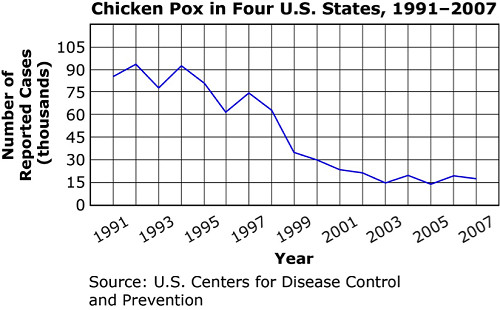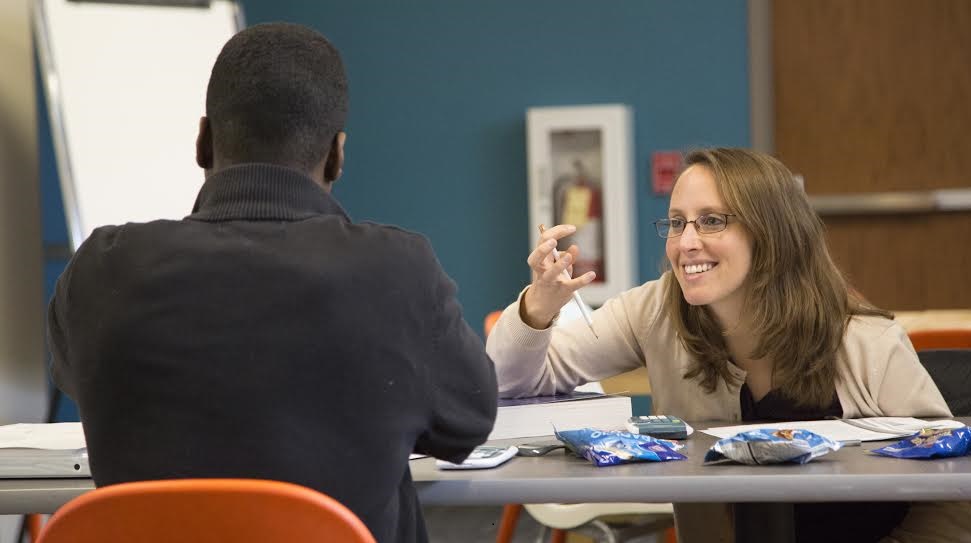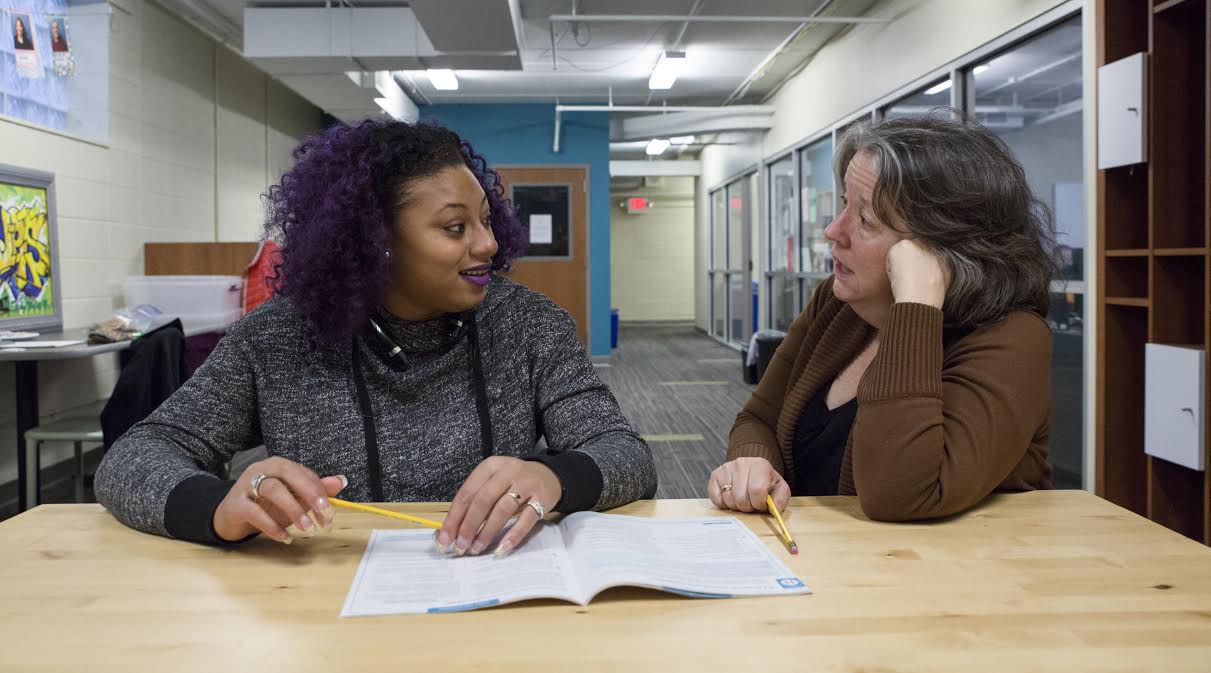Obtaining a GED is a Crucial Step for YouthLink Clients Striving to Make a Better Life
 Saturday, February 18, 2017 at 8:59AM |
Saturday, February 18, 2017 at 8:59AM |  Claudia Kittock |
Claudia Kittock | Article by Claudia Kittock, photos Danae Hudson of YouthLink
I have been an educator for my entire adult life. It is the only profession I have ever practiced. I have been fortunate enough to teach preschool through Ph.D. level courses and have enjoyed all levels. During that time I, of course, was aware of the GED exam, but truly thought it was a bit silly to think a test would take the place of a high school education. I learned how very wrong I was when I began to volunteer at YouthLink, tutoring young people who were experiencing homelessness and working toward passing the GED exam. Do you think I am wrong? Try this question from a GED exam.
Sample question from GED:
Varicella is a virus that causes the disease chicken pox. Medications are used to treat the symptoms of fever and discomfort associated with chicken pox. In 1995, a varicella vaccine was made available to people in the United States.
This graph shows the number of chicken pox cases reported in four U.S. states from 1991 to 2007.

Which conclusion is supported by the data in the graph?
A. The varicella vaccine relieves chicken pox symptoms.
B. The varicella vaccine is effective in treating chicken pox.
C. The varicella vaccine is effective in preventing chicken pox.
D. The varicella vaccine has eliminated chicken pox from the United States.
Did you get the right answer? Did it ‘pop’ into your mind or did it require some thought? The GED exam is not easy by any measure and is designed to elicit problem-solving skills and higher level thinking. As a college professor teaching freshman level classes, I would welcome students who had passed the GED, confident they were ready to do the type of thinking needed in a general psychology course.
“None of my grandparents graduated from
high school, neither of my parents, none
of my aunts and uncles, and none of my
cousins. I’m the first, and my brother
has watched me do this and is now
working on his GED. Things get better
when you work hard.”
The first student I met at YouthLink as a tutor was Danny (all names used here are pseudonyms). He is a quiet, very smart young man who has been on and off the streets for 4 years. As with all the students I teach, he taught me far more than I have taught him. Danny explained what it was like to experience homelessness, which overpasses were ‘safest’ to sleep under, and how being on the street with a partner was essential. While one person slept, the other kept watch for dangers, and kept track of the time so that neither slept too long in the bitter cold.
When I asked Danny what he wanted to do with his life, he told me he wants to be a chef. He has always cooked for his family and loved the feeling of preparing good food for people he cares for. Every day when I left, I asked Danny if he had a warm and safe place to sleep. His response? "Don’t worry about me! You just get home safely.”

 Above, tutors work with students
Above, tutors work with students
Every student begins the work of passing the GED exam by taking practice tests in each of the 4 subtest areas of science, mathematical reasoning, social studies, and reasoning through language arts. When the student finishes a practice test on the computer, they will get a printout with the score and what areas need more work. These printouts tell them the practice books to work on and the page numbers of the work they need to help them boost their score.
That’s where the work of the tutor begins. I always begin with a discussion about how each student learns best. There is a common thread with most of my students. At some point in their life as a student they learned that they were ‘dumb’, that learning would always be difficult for them, and that anything associated with learning is boring. We talk about their experiences while I attempt to explain that what happened to them was wrong.
My job with my students is to help them understand the skills they do possess and to use those skills for problem solving. Each of these students comes to YouthLink with problem solving skills. Most don’t realize that. Most don’t understand how smart they need to be to have managed to stay alive in truly horrible circumstances, and to somehow find their way to us.
Deciding to pass a GED test is a daunting prospect. Most of the students I work with have far more pressing matters that they must deal with, but each of them wants a future. Each of them wants more out of life, and have decided that GED is the first step.
Dr. Heather Huseby, Executive Director of YouthLink, taught me that the most important thing we do at YouthLink is to support youth in finding a path forward. Many come with true despair about their lives, and gently supporting and nudging them forward is the centerpiece of the work done at YouthLink.
Last week, a young woman, LaToya, put a piece of paper in front of me, sat in the chair next to me and grinned from ear to ear. The paper was her certification of a completed GED. When the celebrating died down, I asked her how her family felt. She said, “None of my grandparents graduated from high school, neither of my parents, none of my aunts and uncles, and none of my cousins. I’m the first, and my brother has watched me do this and is now working on his GED. Things get better when you work hard.”
 LaToya and Claudia
LaToya and Claudia
I go to tutor every week because I leave feeling more optimistic about the world. I meet people every week who are survivors, who refuse to let life’s obstacles stop them. I come home energized and upbeat about the future. I am honored by my work and association with the people of YouthLink.
If you are interested in making a difference in the lives of these young people, here are some suggestions:
1. Sign up for the newsletter at http://www.youthlinkmn.org/newsletter/
2. Learn more about youth homelessness at http://www.youthlinkmn.org/the-cost-of-homelessness/
3. Sign up for the Night of Hope at http://www.youthlinkmn.org/night-of-hope-sleep-out/
4. Get involved at YouthLink at http://www.youthlinkmn.org/get-involved/
Oh...did you get the right answer to the sample question??? I will leave that up to you to decide!
Claudia can be reached at claudia@millcitymedia.org
